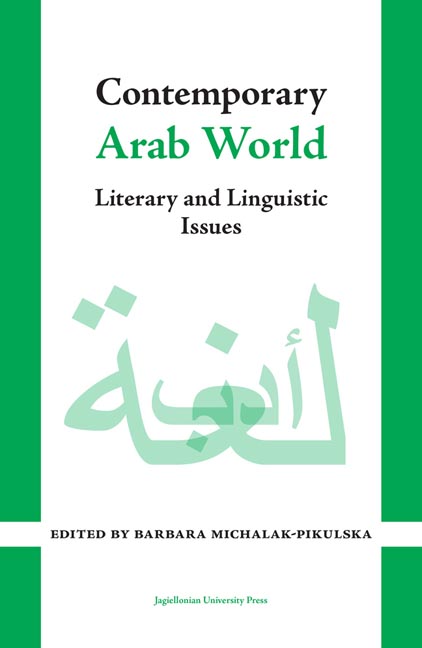Book contents
- Frontmatter
- Contents
- Introduction
- Between past achievements and future challenges Arabic language teaching at the university level – example of the Department of Arabic Studies at the Jagiellonian University in Cracow
- Meanings and functions of genitive constructions in Modern Standard Arabic
- Sultan Qaboos – image of the ruler in panegyrics and elegies by Omani poets
- Microfiction, flash fiction or very short story in modern Arabic literature
- In the maze of discourses – monodrama Bāy bāy Ğīllū (Bye Bye Gillo) by Ṭaha ‘Adnān
- Women in Islamic State propaganda
- Annex
Meanings and functions of genitive constructions in Modern Standard Arabic
Published online by Cambridge University Press: 14 October 2023
- Frontmatter
- Contents
- Introduction
- Between past achievements and future challenges Arabic language teaching at the university level – example of the Department of Arabic Studies at the Jagiellonian University in Cracow
- Meanings and functions of genitive constructions in Modern Standard Arabic
- Sultan Qaboos – image of the ruler in panegyrics and elegies by Omani poets
- Microfiction, flash fiction or very short story in modern Arabic literature
- In the maze of discourses – monodrama Bāy bāy Ğīllū (Bye Bye Gillo) by Ṭaha ‘Adnān
- Women in Islamic State propaganda
- Annex
Summary
In Arabic and in other Semitic languages a substantive (standing in the genitive case) may occur as nomen rectum i.e. as genitival qualifier that determines another substantive, which precedes it and stands in the construct state (status constructus). Some substantives – as well as adjectives and numerals – if occur as nomen regens in genitive constructions, on account of their semantic properties require (as nomen rectum) substantives having particular grammatical properties. The form of a genitive qualifier determines then the meaning of the determined noun and of the whole phrase.
In this paper I am going to investigate, how the form of a qualifier (its definiteness vs. indefiniteness and number) differentiates meanings of such constructions as well as of their heads.
There are numerous studies on genitive constructions and in most cases they constitute parts of monographs on the entire system of Arabic language or its syntax. Among them there are titles quoted in this paper: J. Danecki (2001), El-Said Badawi, M.G. Carter, A. Gully (2004), R. Buckley (2004), C. Holes (2004), K.C. Ryding (2005). Usually they focus on lexemes appearing as nomen regens and analyse their syntactic and semantic functions.
Aims of this paper are: (i) to group genitive constructions according to the grammatical form of a qualifier; (ii) to indicate how the elements of meaning present throughout such groups depend on the form of a qualifier.
Below I present a list of possible models of that construction, in which in the position of genitival qualifier there occur indefinite or definite nouns. The examples I present, are divided into three groups according to the grammatical form of the qualifiers, which can be: (i) indefinite nouns, (ii) definite nouns. Then for comparison: (iii) indefinite or definite nouns in cases when definiteness or indefiniteness of the qualifier does not affect the meaning of the whole phrase. In conclusion I indicate semantic consequences of particular combinations. Numerous examples are intended to show various possible contexts, in which particular qualifier may occur, and to highlight differences in meaning resulting from various grammatical forms of qualifiers.
In the analyzed phrases as the determined nouns (nomen regens) there occur substantives, adjectives or numerals. The case in which determined noun stands, depends on the syntactic function of the whole phrase. A noun which occurs in this position has no prepositive definite article nor nunation. As nomen regens there sometimes occur proper names.
- Type
- Chapter
- Information
- Contemporary Arab WorldLiterary and Linguistic Issues, pp. 31 - 68Publisher: Jagiellonian University PressPrint publication year: 2020

